14.10: Forced Oscillations and Resonance
- Last updated
- May 12, 2023
- Save as PDF
- Page ID
- 128086
( \newcommand{\kernel}{\mathrm{null}\,}\)
Let us consider to the example of a mass on a spring. We now examine the case of forced oscillations, which we did not yet handle. That is, we consider the equation
mx″+cx′+kx=F(t)
for some nonzero F(t). The setup is again: m is mass, c is friction, k is the spring constant, and F(t) is an external force acting on the mass.
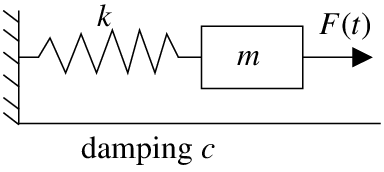
What we are interested in is periodic forcing, such as noncentered rotating parts, or perhaps loud sounds, or other sources of periodic force. Once we learn about Fourier series in Chapter 4, we will see that we cover all periodic functions by simply considering F(t)=F0cos(ωt) (or sine instead of cosine, the calculations are essentially the same).
Below is a video on solving a forced oscillations problem.
Undamped Forced Motion and Resonance
First let us consider undamped c=0 motion for simplicity. We have the equation
mx″+kx=F0cos(ωt)
This equation has the complementary solution (solution to the associated homogeneous equation)
xc=C1cos(ω0t)+C2sin(ω0t)
where ω0=√km is the natural frequency (angular), which is the frequency at which the system “wants to oscillate” without external interference.
Let us suppose that ω0≠ω. We try the solution xp=Acos(ωt) and solve for A. Note that we need not have sine in our trial solution as on the left hand side we will only get cosines anyway. If you include a sine it is fine; you will find that its coefficient will be zero.
We solve using the method of undetermined coefficients. We find that
xp=F0m(ω20−ω2)cos(ωt)
We leave it as an exercise to do the algebra required.
The general solution is
x=C1cos(ω0t)+C2sin(ω0t)+F0m(ω20−ω2)cos(ωt)
or written another way
x=Ccos(ω0t−y)+F0m(ω20−ω2)cos(ωt)
Hence it is a superposition of two cosine waves at different frequencies.
Example 14.10.1
Take
0.5x″+8x=10cos(πt),x(0)=0,x′(0)=0
Let us compute. First we read off the parameters: ω=π,ω0=√80.5=4,F0=10,m=0.5. The general solution is
x=C1cos(4t)+C2sin(4t)+2016−π2cos(πt)
Solve for C1 and C2 using the initial conditions. It is easy to see that C1=−2016−π2 and C2=0. Hence
x=2016−π2(cos(πt)−cos(4t))
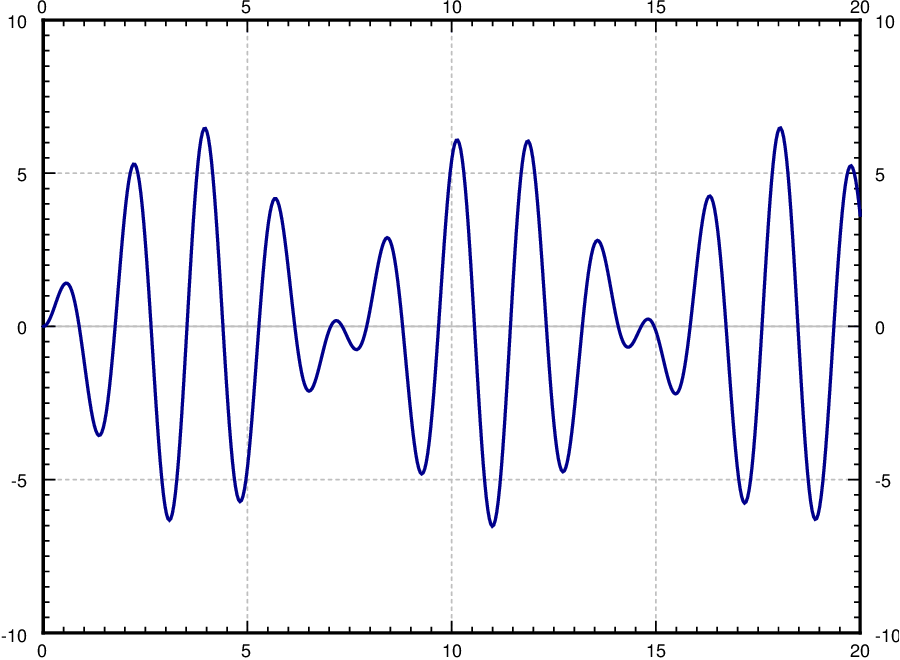
Notice the “beating” behavior in Figure 14.10.2. First use the trigonometric identity
2sin(A−B2)sin(A+B2)=cosB−cosA
to get that
x=2016−π2(2sin(4−π2t)sin(4+π2t))
Notice that x is a high frequency wave modulated by a low frequency wave.
Now suppose that ω0=ω. Obviously, we cannot try the solution Acos(ωt) and then use the method of undetermined coefficients. We notice that cos(ωt) solves the associated homogeneous equation. Therefore, we need to try xp=Atcos(ωt)+Btsin(ωt). This time we do need the sine term since the second derivative of tcos(ωt) does contain sines. We write the equation
x″+ω2x=F0mcos(ωt)
Plugging xp into the left hand side we get
2Bωcos(ωt)−2Aωsin(ωt)=F0mcos(ωt)
Hence A=0 and B=F02mω. Our particular solution is F02mωtsin(ωt) and our general solution is
x=C1cos(ωt)+C2sin(ωt)+F02mωtsin(ωt)
The important term is the last one (the particular solution we found). We can see that this term grows without bound as t→∞. In fact it oscillates between F0t2mω and −F0t2mω. The first two terms only oscillate between ±√C21+C22, which becomes smaller and smaller in proportion to the oscillations of the last term as t gets larger. In Figure 14.10.3 we see the graph with C1=C2=0,F0=2,m=1,ω=π.
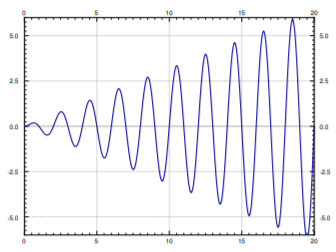
By forcing the system in just the right frequency we produce very wild oscillations. This kind of behavior is called resonance or perhaps pure resonance. Sometimes resonance is desired. For example, remember when as a kid you could start swinging by just moving back and forth on the swing seat in the “correct frequency”? You were trying to achieve resonance. The force of each one of your moves was small, but after a while it produced large swings.
On the other hand resonance can be destructive. In an earthquake some buildings collapse while others may be relatively undamaged. This is due to different buildings having different resonance frequencies. So figuring out the resonance frequency can be very important.
A common (but wrong) example of destructive force of resonance is the Tacoma Narrows bridge failure. It turns out there was a different phenomenon at play.1
Below is a video on solving a differential equation that comes from a vibrating system with resonance.
Damped Forced Motion and Practical Resonance
In real life things are not as simple as they were above. There is, of course, some damping. Our equation becomes
mx″+cx′+kx=F0cos(ωt),
for some c>0. We have solved the homogeneous problem before. We let
p=c2mω0=√km
We replace equation (???) with
x″+2px′+ω20x=F0mcos(ωt)
The roots of the characteristic equation of the associated homogeneous problem are r1,r2=−p±√p2−ω20. The form of the general solution of the associated homogeneous equation depends on the sign of p2−ω20, or equivalently on the sign of c2−4km, as we have seen before. That is,
xc={C1er1t+C2er2t,if c2>4km,C1ept+C2te−pt,if c2=4km,e−pt(C1cos(ω1t)+C2sin(ω1t)),if c2<4km,
where ω1=√ω20−p2. In any case, we can see that xc(t)→0 as t→∞. Furthermore, there can be no conflicts when trying to solve for the undetermined coefficients by trying xp=Acos(ωt)+Bsin(ωt). Let us plug in and solve for A and B. We get (the tedious details are left to reader)
((ω20−ω2)B−2ωpA)sin(ωt)+((ω20−ω2)A+2ωpB)cos(ωt)=F0mcos(ωt)
We get that
A=(ω20−ω2)F0m(2ωp)2+m(ω20−ω2)2
B=2ωpF0m(2ωp)2+m(ω20−ω2)2
We also compute C=√A2+B2 to be
C=F0m√(2ωp)2+(ω20−ω2)2
Thus our particular solution is
xP=(ω20−ω2)F0m(2ωp)2+m(ω20−ω2)2cos(ωt)+2ωpF0m(2ωp)2+m(ω20−ω2)2sin(ωt)
Or in the alternative notation we have amplitude C and phase shift γ where (if ω≠ω0)
tanγ=BA=2ωpω20−ω2
Hence we have
xp=F0m√(2ωp)2+(ω20−ω2)2cos(ωt−γ)
If ω=ω0 we see that A=0,B=C=F02mωp, and γ=π2.
The exact formula is not as important as the idea. Do not memorize the above formula, you should instead remember the ideas involved. For different forcing function F, you will get a different formula for xp. So there is no point in memorizing this specific formula. You can always recompute it later or look it up if you really need it.
For reasons we will explain in a moment, we call xcthe transient solution and denote it by xtr. We call the xp we found above the steady periodic solution and denote it by xsp. The general solution to our problem is
x=xc+xp=xtr+xsp
We note that xc=xtr goes to zero as t→∞, as all the terms involve an exponential with a negative exponent. Hence for large t, the effect of xtr is negligible and we will essentially only see xsp. Hence the name transient. Notice that xsp involves no arbitrary constants, and the initial conditions will only affect xtr. This means that the effect of the initial conditions will be negligible after some period of time. Because of this behavior, we might as well focus on the steady periodic solution and ignore the transient solution. See Figure 14.10.4 for a graph of different initial conditions.
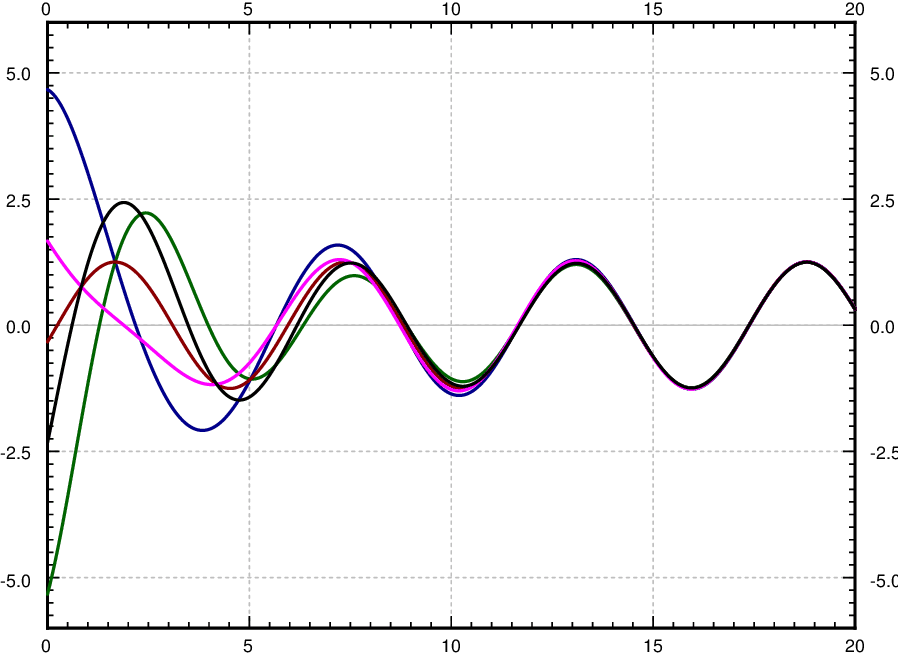
Notice that the speed at which xtr goes to zero depends on P (and hence c). The bigger P is (the bigger c is), the “faster” xtr becomes negligible. So the smaller the damping, the longer the “transient region.” This agrees with the observation that when c=0, the initial conditions affect the behavior for all time (i.e. an infinite “transient region”).
Let us describe what we mean by resonance when damping is present. Since there were no conflicts when solving with undetermined coefficient, there is no term that goes to infinity. What we will look at however is the maximum value of the amplitude of the steady periodic solution. Let C be the amplitude of xsp. If we plot C as a function of ω (with all other parameters fixed) we can find its maximum. We call the ω that achieves this maximum the practical resonance frequency. We call the maximal amplitude C(ω) the practical resonance amplitude. Thus when damping is present we talk of practical resonance rather than pure resonance. A sample plot for three different values of c is given in Figure 14.10.5. As you can see the practical resonance amplitude grows as damping gets smaller, and any practical resonance can disappear when damping is large.
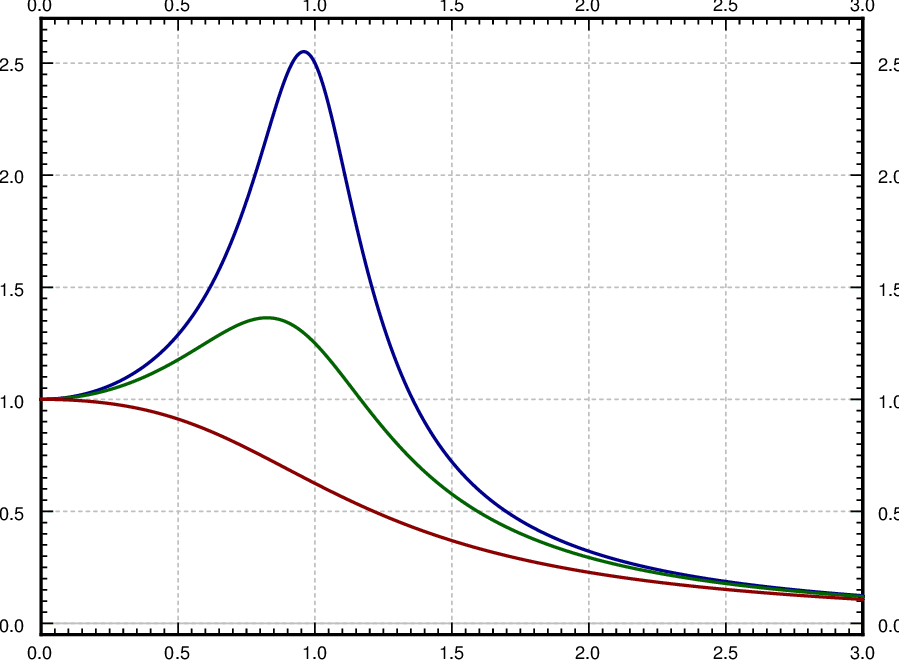
To find the maximum we need to find the derivative C′(ω). Computation shows
C′(ω)=−4ω(2p2+ω2−ω20)F0m((2ωp)2+(ω20−ω2))3/2
This is zero either when ω=0 or when 2p2+ω2−ω20=0. In other words, C′(ω)=0 when
ω=√ω20−2p2 or ω=0
It can be shown that if ω20−2p2 is positive, then √ω20−2p2 is the practical resonance frequency (that is the point where C(ω) is maximal, note that in this case C′(ω)>0 for small ω). If ω=0 is the maximum, then essentially there is no practical resonance since we assume that ω>0 in our system. In this case the amplitude gets larger as the forcing frequency gets smaller.
If practical resonance occurs, the frequency is smaller than ω0. As the damping c (and hence P) becomes smaller, the practical resonance frequency goes to ω0. So when damping is very small, ω0 is a good estimate of the resonance frequency. This behavior agrees with the observation that when c=0, then ω0 is the resonance frequency.
Another interesting observation to make is that when ω→∞, then ω→0. This means that if the forcing frequency gets too high it does not manage to get the mass moving in the mass-spring system. This is quite reasonable intuitively. If we wiggle back and forth really fast while sitting on a swing, we will not get it moving at all, no matter how forceful. Fast vibrations just cancel each other out before the mass has any chance of responding by moving one way or the other.
The behavior is more complicated if the forcing function is not an exact cosine wave, but for example a square wave. A general periodic function will be the sum (superposition) of many cosine waves of different frequencies. The reader is encouraged to come back to this section once we have learned about the Fourier series.
Footnotes
1K. Billah and R. Scanlan, Resonance, Tacoma Narrows Bridge Failure, and Undergraduate Physics Textbooks, American Journal of Physics, 59(2), 1991, 118–124, http://www.ketchum.org/billah/Billah-Scanlan.pdf




